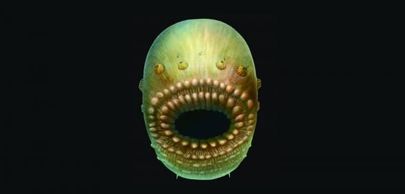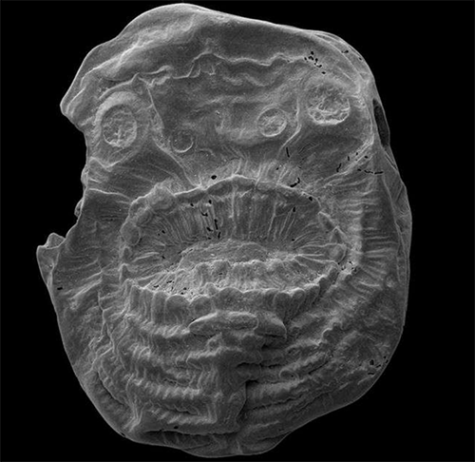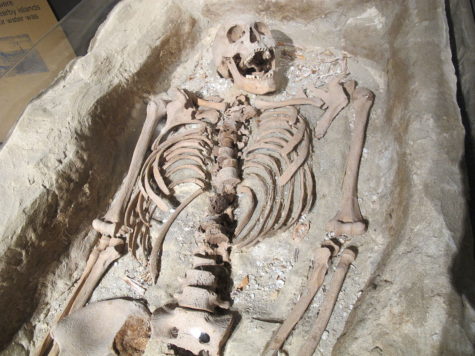

Let’s get down to brass tacks. Mouth. Anus. Reproductive bit in between. Isn’t that all one really needs to get by?
I’m oversimplifying, of course. Lungs are helpful if you live on land, for example.
But check out our newly discovered really ancient fossilized ancestor. Saccorhytus coronarious, unearthed recently by paleontologists in sedimentary rock in the Shaanxi Province of central China, falls into the group of bilateral creatures known as deuterostomes. (Here’s a nice description of that group.) Hardly an exclusive club, the deuterostomes include critters like starfish and urchins, but also giraffes, naked mole rats, and humans. All vertebrates, in fact. This particular animal’s body was a little more than a globular bag. It had a supersize wrinkly maw-anus combo (decluttering is not a new concept). Its form, at some 540 million years old, proves that we vertebrates have been pushing around our greedy mouths to stuff our faces, and letting fly the excess, for a really long time.
I’m truly amazed by how much paleontologists can figure out from microscopic lines left in stone. Having examined this millimeter-long creature under an electron microscope—without which the thing appears to be a grain of black rice— the scientists can say with some confidence where the animal lived (on the sea bed), how it moved (by wriggling and nestling between sand grains), and what its peculiar parts were for (e.g., lateral slits probably let it flush out excess water (precursors to modern gills), while mouth folds let it open extra wide when prey was bigger than predator’s head).
The researchers also know what the animal lacked: an anus. It had no dedicated release valve. No clearly marked exit. Apparently, butts aren’t mandatory after all. For some animals, a mouth or other opening does double duty. (See what I did there? Of course you do.)
So, here is the common ancestor of whole host of species, for now the earliest known knot in the evolutionary net that stretched to humans hundreds of million years later. (I’m testing out a new analogy for the tree of life. Apologies.)
Such analyses make me feel pretty small. To discover a miniature rock imprinted with what is clearly an alien face with four chins and maxed-out lips, and then to figure out aspects of the ancient animal’s physiology and behavior, life history, and its relationship to humans, well, that’s quite a thing.
I’m not sure whether my much younger self would have been as impressed. When I was in 5th grade we kids had the chance to go to work with someone who had the job we thought we wanted when we grew up. There were few marine mammologists hanging around Chicago, so I opted for my second choice. I hopped into a pickup truck at dawn with a soft-spoken bearded paleontologist and traveled to a site in Wisconsin where an excavation was in progress. I don’t remember what we were looking for there; I just know I was hoping for skeletons. Lots and lots of skeletons.
I recall the tidy square pits, some sunken like 1970s living rooms, and spray-painted markings in the dirt. Students with tremendous patience, in wide-brimmed hats, knelt on the hard ground sifting out tiny nothings from the dust. I was given a couple of tools and shown how to very carefully scrape away the earth around objects and brush away the excess. My digging experience limited to building drip sand castles, the area I was given to work was no doubt insignificant. If memory serves, I spent several hours gently freeing a stick from the soil.

Memory definitely serves when it comes to the pain. The sun was a fireball stuck under my hat, and the ground punished my knees. My back was quickly drenched and sore and the edges of my ears turned an angry red. I hobbled around the next day as if I’d fallen into a well. It was the most tedious work I’d ever done, and by then I’d diagrammed a lot of sentences. Where was the grinning skull, the bony hand, the eerily crooked spine rising from the grave? I probably cried at some point that day.
Now, a day poking around in the dirt, even sans skeletons, sounds like a good time. (Being an adult has its perks, including enthusiasm over geeky things that don’t come easy.) If only that scientist had lied to me, telling me that somewhere under my bruised knees lay the imprint of our earliest ancestor’s absurd “face,” a find that would fill a gap in the fossil record so vital it would change everything we knew about everything. (A little drama makes all the difference in 5th grade.)
Just that little fib and maybe, just maybe, I’d be a happily sunburned paleontologist today.
Illustration: S. Conway Morris/Jian Han
Fossil photo: Jian Han
Skeleton: By Marlene Oostryck (Wiki Takes Fremantle participant) – Uploaded from Wiki Takes Fremantle, CC BY 3.0, https://commons.wikimedia.org/w/index.php?curid=17313019